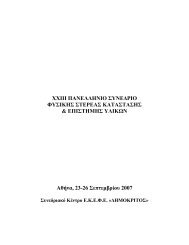A natron source at Pikrolimni Lake in Greece? Geochemical evidence
A natron source at Pikrolimni Lake in Greece? Geochemical evidence
A natron source at Pikrolimni Lake in Greece? Geochemical evidence
Create successful ePaper yourself
Turn your PDF publications into a flip-book with our unique Google optimized e-Paper software.
E. Dotsika et al. / Journal of <strong>Geochemical</strong> Explor<strong>at</strong>ion 103 (2009) 133–143<br />
141<br />
64% of all salts th<strong>at</strong> precipit<strong>at</strong>e, while halite only 10%. On the contrary,<br />
Fig. 6 shows the results of PL-5/2003 sample when the <strong>in</strong>itial chemical<br />
composition of this w<strong>at</strong>er was modeled. It seems th<strong>at</strong> when the model<br />
stops halite is more abundant <strong>in</strong> the precipit<strong>at</strong>es than trona: trona<br />
represents only 0.5% of all salts th<strong>at</strong> precipit<strong>at</strong>e, while halite 60%.<br />
These two models show the change which may have happened <strong>in</strong> the<br />
w<strong>at</strong>er chemistry of the lake's spr<strong>in</strong>gs and why trona is so hard to f<strong>in</strong>d<br />
<strong>in</strong> <strong>Lake</strong> <strong>Pikrolimni</strong> when the models reaches their lowest po<strong>in</strong>t: trona<br />
salts are hoarded by the deposition of large quantities of halite, as<br />
shown by Shortland et al. (2006) <strong>in</strong> their study about Wadi N<strong>at</strong>run.<br />
The aliment<strong>at</strong>ion of the lake <strong>in</strong> the past had happened ma<strong>in</strong>ly from<br />
deep spr<strong>in</strong>gs with similar chemistry while today is arisen ma<strong>in</strong>ly from<br />
meteoric w<strong>at</strong>ers and irrig<strong>at</strong>ion groundw<strong>at</strong>ers (Pl<strong>in</strong>y; Many public<br />
testimonies vouch th<strong>at</strong> there were a lot of spr<strong>in</strong>gs <strong>in</strong> the middle of<br />
the lake, but after the big earthquake of 1981 these spr<strong>in</strong>gs have<br />
disappeared).<br />
The chemical composition of the residual w<strong>at</strong>er and of three samples<br />
(S/1/2002; b/2/2002; PL-5/2003) after the simul<strong>at</strong>ion of evapor<strong>at</strong>ion<br />
was similar with the chemical composition of the lake's w<strong>at</strong>er <strong>in</strong><br />
conditions of <strong>in</strong>tense evapor<strong>at</strong>ion (Table 5).<br />
Especially the chemical composition of the residual w<strong>at</strong>er, coded<br />
S/1/2002, after the evapor<strong>at</strong>ion simul<strong>at</strong>ion, is similar to th<strong>at</strong> of the<br />
lake br<strong>in</strong>e PL-9/2006 (Table 5). Furthermore, the model shows th<strong>at</strong><br />
<strong>n<strong>at</strong>ron</strong> starts to precipit<strong>at</strong>e when Cl − content is 1417 mmol/L [when<br />
the concentr<strong>at</strong>ion factor (CF) is about 395 times: 395⁎3.8 mmol/L<br />
(<strong>in</strong>itial Cl of s/1/2002)=1500 mmol/L] while trona starts to precipit<strong>at</strong>e<br />
when Cl − content is approxim<strong>at</strong>ely 2500 mmol/L [when the<br />
concentr<strong>at</strong>ion factor (CF) is about 720 times: 700⁎3.8 mmol/L (<strong>in</strong>itial Cl<br />
of s/1/2002)=2651 mmol/L]. The lake w<strong>at</strong>er reaches similar concentr<strong>at</strong>ions<br />
only dur<strong>in</strong>g the summer, August (but not every summer), as<br />
observed by sampl<strong>in</strong>g. Accord<strong>in</strong>g to Pl<strong>in</strong>y, <strong>n<strong>at</strong>ron</strong> was collected <strong>in</strong><br />
Macedonia only <strong>in</strong> the ris<strong>in</strong>g of the Dog Star for n<strong>in</strong>e days. This tim<strong>in</strong>g<br />
places this event <strong>at</strong> the beg<strong>in</strong>n<strong>in</strong>g of the hottest part of the summer,<br />
when the lake is found <strong>at</strong> the peak of evapor<strong>at</strong>ion and trona starts to<br />
precipit<strong>at</strong>e. However, the lake does not reach such high concentr<strong>at</strong>ions<br />
every year, a fact th<strong>at</strong> is due to the we<strong>at</strong>her (temper<strong>at</strong>ure,<br />
humidity, precipit<strong>at</strong>ion). Therefore, the collection would have been<br />
tak<strong>in</strong>g place only dur<strong>in</strong>g particularly hot and dry summers.<br />
7. Conceptual model<br />
Fig. 5. S<strong>at</strong>ur<strong>at</strong>ion Index (Log s<strong>at</strong>ur<strong>at</strong>ion r<strong>at</strong>io) versus ionic strength (logarithmic). White<br />
triangles: nahcolite; x: gaylussite; –: pirssonite; white diamonds: <strong>n<strong>at</strong>ron</strong>; black<br />
squares: trona; white circles: halite; crosses: mirabilite; white squares: thenardite;<br />
crossed x: thermon<strong>at</strong>rite.<br />
CaCO 3 þ 2Na þ CO 3 þ 2H 2 O↔Na 2 Ca⁎ðCO 3 Þ 2<br />
⁎2H 2 O:<br />
Also when the concentr<strong>at</strong>ion factor (CF) is about 700 times of the<br />
<strong>in</strong>itial chemical composition, burkeite and trona precipit<strong>at</strong>ion <strong>in</strong>iti<strong>at</strong>es.<br />
Much l<strong>at</strong>er, when the w<strong>at</strong>er is concentr<strong>at</strong>ed by about a factor of<br />
1200, halite beg<strong>in</strong>s to precipit<strong>at</strong>e. When the models stop, halite and<br />
trona are the more abundant precipit<strong>at</strong>es. Trona is more abundant <strong>in</strong><br />
the precipit<strong>at</strong>es than halite: trona (50%) and <strong>n<strong>at</strong>ron</strong> (14%) represent<br />
The Na/Cl r<strong>at</strong>io <strong>in</strong> <strong>Lake</strong> <strong>Pikrolimni</strong> supports evapor<strong>at</strong>ive concentr<strong>at</strong>ions<br />
as the dom<strong>in</strong>ant process <strong>in</strong> the chemical evolution of these lake<br />
w<strong>at</strong>ers th<strong>at</strong> have high proportions of Na + and HCO 3 − . The derived high<br />
Na + and HCO 3 − contents are due to silic<strong>at</strong>e hydrolysis. The comput<strong>in</strong>g<br />
program has shown th<strong>at</strong> the dilute spr<strong>in</strong>g <strong>in</strong>flow was concentr<strong>at</strong>ed (by<br />
the assumption of Cl − conserv<strong>at</strong>ion <strong>in</strong> solution throughout evapor<strong>at</strong>ion)<br />
about 12000 times to obta<strong>in</strong> the most sal<strong>in</strong>e residual actual lake w<strong>at</strong>er,<br />
PL-8/2002; PL-9/2006). However, this evapor<strong>at</strong>ion budget calcul<strong>at</strong>ion<br />
(Table 5), if compared with the actual analysis of the most sal<strong>in</strong>e<br />
<strong>Pikrolimni</strong> br<strong>in</strong>e, shows th<strong>at</strong> some constituents are not conserv<strong>at</strong>ive,<br />
due to different removal mechanisms. Therefore, it is believed th<strong>at</strong> <strong>in</strong> the<br />
past, the solute composition of such w<strong>at</strong>ers, which are controlled by<br />
silic<strong>at</strong>e hydrolysis and evapor<strong>at</strong>ive concentr<strong>at</strong>ion, gave the <strong>n<strong>at</strong>ron</strong> salts<br />
of <strong>Lake</strong> <strong>Pikrolimni</strong>. Namely, <strong>in</strong> the past, after acquisition of solutes from<br />
<strong>at</strong>mospheric precipit<strong>at</strong>ion, hydrolysis of silic<strong>at</strong>e and possibly CO 2 of<br />
deep orig<strong>in</strong>, the w<strong>at</strong>ers are subjected to evapor<strong>at</strong>ion (<strong>at</strong> the surface or by<br />
capillarity). Initially, the concentr<strong>at</strong>ions of all constituents <strong>in</strong>crease until<br />
the m<strong>in</strong>eral precipit<strong>at</strong>ion occurs. The precipit<strong>at</strong>ion may take the form of<br />
efflorescent crusts on top of the surface or of <strong>in</strong>tergranural caliche-type<br />
films and cements. The efflorescent crusts are the product of complete<br />
desicc<strong>at</strong>ion and they are subjected to complete or differential solution<br />
byra<strong>in</strong>.Thisrecycl<strong>in</strong>gofsaltsisobservedactually<strong>at</strong><strong>Lake</strong><strong>Pikrolimni</strong>.<br />
Thus, dur<strong>in</strong>g summer when the w<strong>at</strong>er level of the lake is low or there is<br />
no w<strong>at</strong>er <strong>at</strong> all (total desicc<strong>at</strong>ion), the first ra<strong>in</strong>s dissolve the residual<br />
br<strong>in</strong>es (or salts) and get charged by solutes. This recycl<strong>in</strong>g of salts is also
















